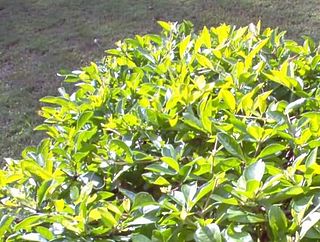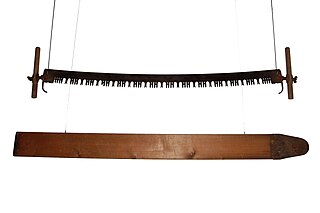Related Research Articles

The olive, botanical name Olea europaea, meaning 'European olive' in Latin, is a species of small tree or shrub in the family Oleaceae, found traditionally in the Mediterranean Basin. When in shrub form, it is known as Olea europaea 'Montra', dwarf olive, or little olive. The species is cultivated in all the countries of the Mediterranean, as well as in Australia, New Zealand, North and South America and South Africa. Olea europaea is the type species for the genus Olea.

Logging is the process of cutting, processing, and moving trees to a location for transport. It may include skidding, on-site processing, and loading of trees or logs onto trucks or skeleton cars.

Dimocarpus longan, commonly known as the longan and dragon's eye, is a tropical tree species that produces edible fruit. It is one of the better-known tropical members of the soapberry family Sapindaceae, to which the lychee and rambutan also belong. The fruit of the longan is similar to that of the lychee, but less aromatic in taste. It is native to tropical Asia and China.

Fruit tree pruning is the cutting and removing of selected parts of a fruit tree. It spans a number of horticultural techniques. Pruning often means cutting branches back, sometimes removing smaller limbs entirely. It may also mean removal of young shoots, buds, and leaves.

Pollarding is a pruning system involving the removal of the upper branches of a tree, which promotes the growth of a dense head of foliage and branches. In ancient Rome, Propertius mentioned pollarding during the 1st century BCE. The practice occurred commonly in Europe since medieval times, and takes place today in urban areas worldwide, primarily to maintain trees at a determined height or to place new shoots out of the reach of grazing animals.

In botany, apical dominance is the phenomenon whereby the main, central stem of the plant is dominant over other side stems; on a branch the main stem of the branch is further dominant over its own side twigs.

Horticulture is the branch of agriculture that deals with the art, science, technology, and business of plant cultivation. It includes the cultivation of fruits, vegetables, nuts, seeds, herbs, sprouts, mushrooms, algae, flowers, seaweeds and non-food crops such as grass and ornamental trees and plants. It also includes plant conservation, landscape restoration, landscape and garden design, construction, and maintenance, and arboriculture, ornamental trees and lawns.

A chainsaw is a portable gasoline-, electric-, or battery-powered saw that cuts with a set of teeth attached to a rotating chain driven along a guide bar. It is used in activities such as tree felling, limbing, bucking, pruning, cutting firebreaks in wildland fire suppression, and harvesting of firewood. Chainsaws with specially designed bar-and-chain combinations have been developed as tools for use in chainsaw art and chainsaw mills. Specialized chainsaws are used for cutting concrete during construction developments. Chainsaws are sometimes used for cutting ice; for example, ice sculpture and winter swimming in Finland.

An arborist, tree surgeon, or arboriculturist, is a professional in the practice of arboriculture, which is the cultivation, management, and study of individual trees, shrubs, vines, and other perennial woody plants in dendrology and horticulture.

Pruning is a horticultural, arboricultural, and silvicultural practice involving the selective removal of certain parts of a plant, such as branches, buds, or roots.

Thinning is a term used in agricultural sciences to mean the removal of some plants, or parts of plants, to make room for the growth of others. Selective removal of parts of a plant such as branches, buds, or roots is typically known as pruning.

A crosscut saw is any saw designed for cutting wood perpendicular to (across) the wood grain. Crosscut saws may be small or large, with small teeth close together for fine work like woodworking or large for coarse work like log bucking, and can be a hand tool or power tool.

A two-man saw is a saw designed for use by two sawyers. While some modern chainsaws are so large that they require two persons to control, two-man crosscut saws were primarily important when human power was used. Such a saw would typically be 1 to 4 m long, and sometimes up to 5 m, with a handle at each end. In some cases, such as when felling Giant Sequoias, sawblades could be brazed together end-to-end in order to create longer saws.

Limbing or delimbing is the process of removing branches from a standing or fallen tree trunk.

This article is about risk control methods specific to chainsaws and chainsaw operations.

Safety practices generally recommend that chainsaw users wear protective clothing, also known as personal protective equipment or PPE, while operating chainsaws. There is general agreement worldwide on what clothing is suitable, but local jurisdictions have specific rules and recommendations.

Felling is the process of cutting down trees, an element of the task of logging. The person cutting the trees is a feller. A feller buncher is a machine capable of felling a single large tree or grouping and felling several small ones simultaneously.
Important structures in plant development are buds, shoots, roots, leaves, and flowers; plants produce these tissues and structures throughout their life from meristems located at the tips of organs, or between mature tissues. Thus, a living plant always has embryonic tissues. By contrast, an animal embryo will very early produce all of the body parts that it will ever have in its life. When the animal is born, it has all its body parts and from that point will only grow larger and more mature. However, both plants and animals pass through a phylotypic stage that evolved independently and that causes a developmental constraint limiting morphological diversification.

Mycoforestry is an ecological forest management system implemented to enhance forest ecosystems and plant communities through the introduction of mycorrhizal and saprotrophic fungi. Mycoforestry is considered a type of permaculture and can be implemented as a beneficial component of an agroforestry system. Mycoforestry can enhance the yields of tree crops and produce edible mushrooms, an economically valuable product. By integrating plant-fungal associations into a forestry management system, native forests can be preserved, wood waste can be recycled back into the ecosystem, planted restoration sites are enhanced, and the sustainability of forest ecosystems are improved. Mycoforestry is an alternative to the practice of clearcutting, which removes dead wood from forests, thereby diminishing nutrient availability and reducing soil depth.
This glossary of agriculture is a list of definitions of terms and concepts used in agriculture, its sub-disciplines, and related fields. For other glossaries relevant to agricultural science, see Glossary of biology, Glossary of ecology, Glossary of environmental science, and Glossary of botanical terms.